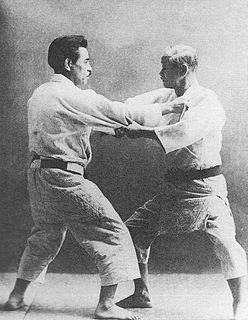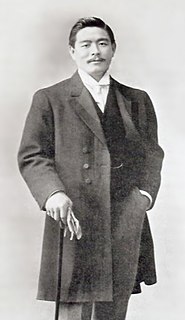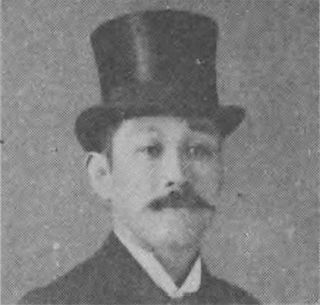
Judo is an unarmed modern Japanese martial art, and Olympic sport. Judo was created in 1882 by Kanō Jigorō as an eclectic martial art, distinguishing itself from its predecessors due to an emphasis on "randori" instead of "kata" alongside its removal of striking and weapon training elements. Judo rose to prominence for its dominance over established jujutsu schools in tournaments hosted by the Tokyo Metropolitan Police Department, resulting in its adoption as the department's primary martial art. A judo practitioner is called a "judoka", and the judo uniform is called "judogi".

The Budokwai in London is the oldest Japanese martial arts club in Europe. It was founded in 1918 by Gunji Koizumi and initially offered tuition in jujutsu, kendo, and other Japanese martial arts. It was the first judo club in Europe.

Mitsuyo Maeda, a Brazilian naturalized as Otávio Maeda , was a Japanese judōka and prizefighter in no holds barred competitions, also being one of the first documented mixed martial artists of the modern era for he frequently challenged practitioners of other martial arts and combat sports. He was known as Count Combat or Conde Koma in Spanish and Portuguese, a nickname he picked up in Spain in 1908. Along with Antônio Soshihiro Satake, he pioneered judo in Brazil, the United Kingdom, and other countries.
Gunji Koizumi, known affectionately by colleagues as G.K., was a Japanese master of judo who introduced this martial art to the United Kingdom, and came to be known as the 'Father of British Judo.' He was the founder of the Budokwai, a pioneering Japanese martial arts society in England. Koizumi helped establish the British Judo Association, and founded the European Judo Union. He held the rank of 8th dan in judo. Koizumi's apparent suicide in 1965 shocked the worldwide judo community.

Kyuzo Mifune has been categorized as one of the greatest exponents of the art of judo after the founder, Kanō Jigorō. He is considered by many to be the greatest judo technician ever, after Kanō.

Yukio Tani was a pioneering Japanese jujutsu and judo instructor and professional challenge wrestler, notable for being one of the first jujutsu stylists to teach and compete outside of Japan.

Jigoro Kano was a Japanese educator, athlete, and the founder of Judo. Along with Ju-Jitsu, Judo was one of the first Japanese martial arts to gain widespread international recognition, and the first to become an official Olympic sport. Pedagogical innovations attributed to Kanō include the use of black and white belts, and the introduction of dan ranking to show the relative ranking among members of a martial art style. Well-known mottoes attributed to Kanō include "maximum efficiency with minimum effort" and "mutual welfare and benefit".

Yamashita Yoshitsugu, also known as Yamashita Yoshiaki, was a Japanese judoka. He was the first person to have been awarded 10th degree red belt (jūdan) rank in Kodokan judo, although posthumously. He was also one of the Four Guardians of the Kodokan, and a pioneer of judo in the United States.

Mikinosuke Kawaishi was a Japanese master of jujutsu and judo who achieved the rank of 7th Dan. He led the development of Judo in France, with Shozo Awazu, and much of Europe and is credited with introducing the colored belt system for differentiating early grades. However, written accounts from the archives of London's Budokwai judo club, founded in 1918, record the use of colored judo belts at the 1926 9th annual Budokwai Display, and a list of ranked colored judokas appears in the Budokwai Committee Minutes of June 1927. Kawaishi visited London and the Budokwai in 1928, and was probably inspired to bring the colored belt system to France. The Fédération Française posthumously awarded him 10th Dan in judo and jujutsu.
Trevor Pryce Leggett was a British judo teacher, author, translator, and head of the BBC's Japanese Service for 24 years. He was one of the first Europeans to study martial arts in Japan. Leggett served in the Ministry of Information during World War II. After the war, he taught judo at the Budokwai and worked in Japanese language services at the BBC. He held the title of Shihan, and the rank of 6th dan in judo from the Kodokan. Leggett helped introduce Japanese culture to the United Kingdom, and was honoured for this by being inducted into Japan's Order of the Sacred Treasure in 1984. He also produced many works on Eastern philosophy.

Yokoyama Sakujirō, was one of the earliest disciples of Kanō Jigorō. He was part of the Kōdōkan Shitennō or Four Guardians of the Kodokan along with Yoshitsugu Yamashita, Tsunejirō Tomita, and Shirō Saigō.
Judo in the United Kingdom has a long history; the martial art being first introduced in 1899, and the first dojo, the Budokwai, being the oldest in Europe. The British Judo Association is the United Kingdom's official governing body for Judo - in which British citizens have won eighteen Olympic medals.
Antonio Satake, born Soshihiro Satake, was a Japanese-born Brazilian martial artist and teacher. One of the teachers of Brazilian martial artist Luiz França, together with Geo Omori and Mitsuyo Maeda, Satake was one of the primary founders of Brazilian jiu-jitsu (BJJ). He pioneered judo in Brazil, the United Kingdom, and other countries.

Mataemon Tanabe was a Japanese jujutsu practitioner and master of the Fusen-ryū school. He became famous for defeating multiple members of the Kodokan in challenge matches, and came to be considered one of the greatest modern jujutsuka.
Fusen-ryū was a traditional school of jujutsu founded by Motsugai Takeda. It contains a complete system of martial arts, including unarmed fighting (jujutsu), staff (bōjutsu), short staff (jojutsu), sword (kenjutsu), sword drawing (iaijutsu), glaive (naginatajutsu), scythe (nagikamajutsu), scythe and chain (kusarigamajutsu) and jitte (jittejutsu).
Ryōi Shintō-ryū Jūjutsu 良移心当流 柔術, is a traditional school of Jujutsu (柔術), founded in the early 17th century by Fukuno Shichirouemon Masakatsu (福野七郎右衛門正勝).

The rivalry between the Kodokan school of judo and the Totsuka school of Yoshin-ryu jujutsu happened in the 1880s during the Meiji Restoration in Japan. Composed by several challenges and tournaments, and its result saw the decline of the traditional jujutsu schools and the rise of judo as an institutionalized martial art. Although surrounded in controversy and legend due to inconsistent sources, it has been considered a vital part of the history of judo.

Matsugoro Okuda was a Japanese jujutsu practitioner and judoka. A master of several styles, he was a contemporary to Jigoro Kano in the creation of a style that synthesized them all, and opposed the early judo movement before later joining it.
Hansuke Nakamura was a Japanese jujutsu practitioner. He was one of the best regarded jujutsu stylists in Japan before the rise of judo, and remains as the most famous exponent of the Ryōi Shintō-ryū school.

Takisaburo Tobari was a Japanese jujutsu and judo practitioner. He was one of the earliest members of Kodokan.













